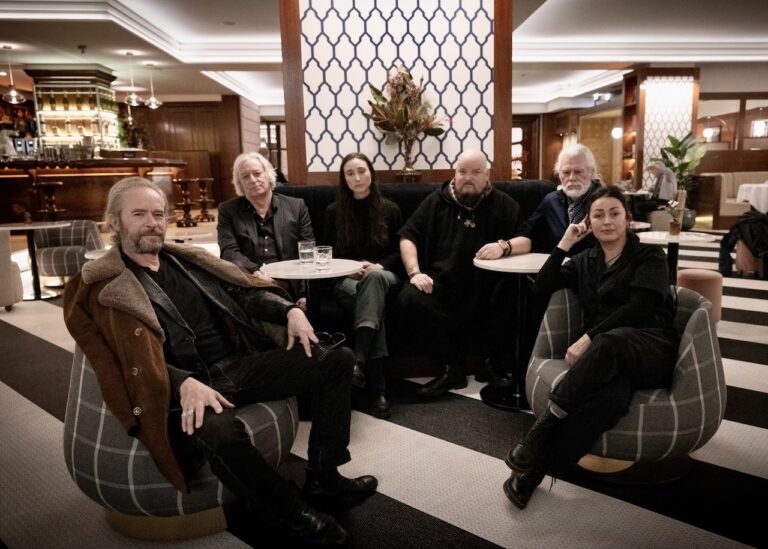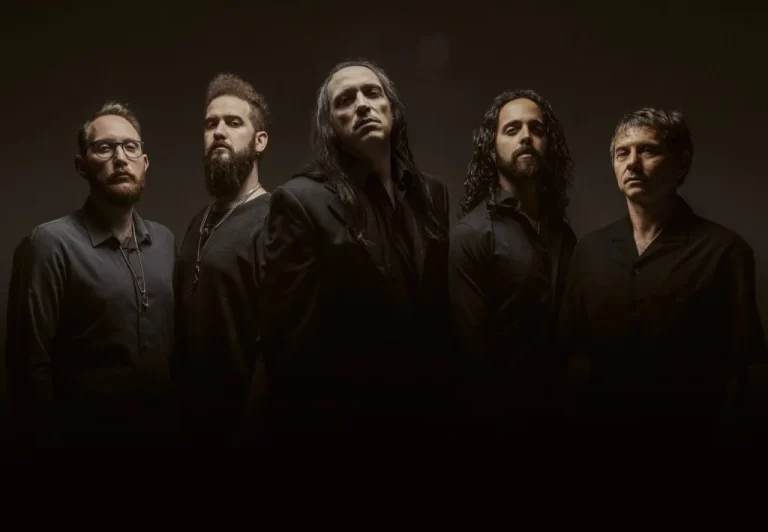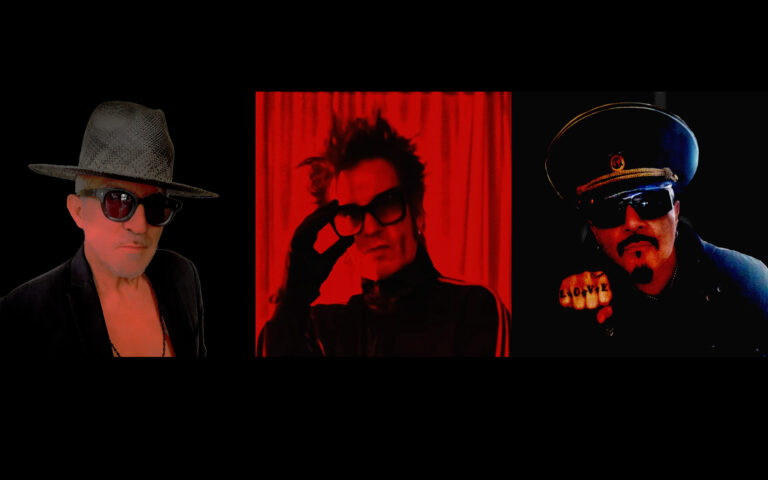It’s one of those days. A backlog of work leads to a head-spinning last hour and when, a little after five, my phone suddenly blazes into life, I’m initially taken aback, only to realise that I’m already several minutes late for an interview with the awesome Bokassa.
Fortunately, Jørn Kaarstad – the band’s laid-back frontman – is incredibly understanding and, once I’ve stuttered out several apologies, we launch into an interview that covers the arrival of the excellent All Out Of Dreams album (which dropped in February 2024 via Indie Recordings).
With the band having been out on the road pretty much throughout 2024, they’re now poised to hit the UK in April (see dates at the end of this feature), making this the perfect time to check in, see how the reaction to All Out Of Dreams has been, and find out more about what the band have planned for the coming live shows.
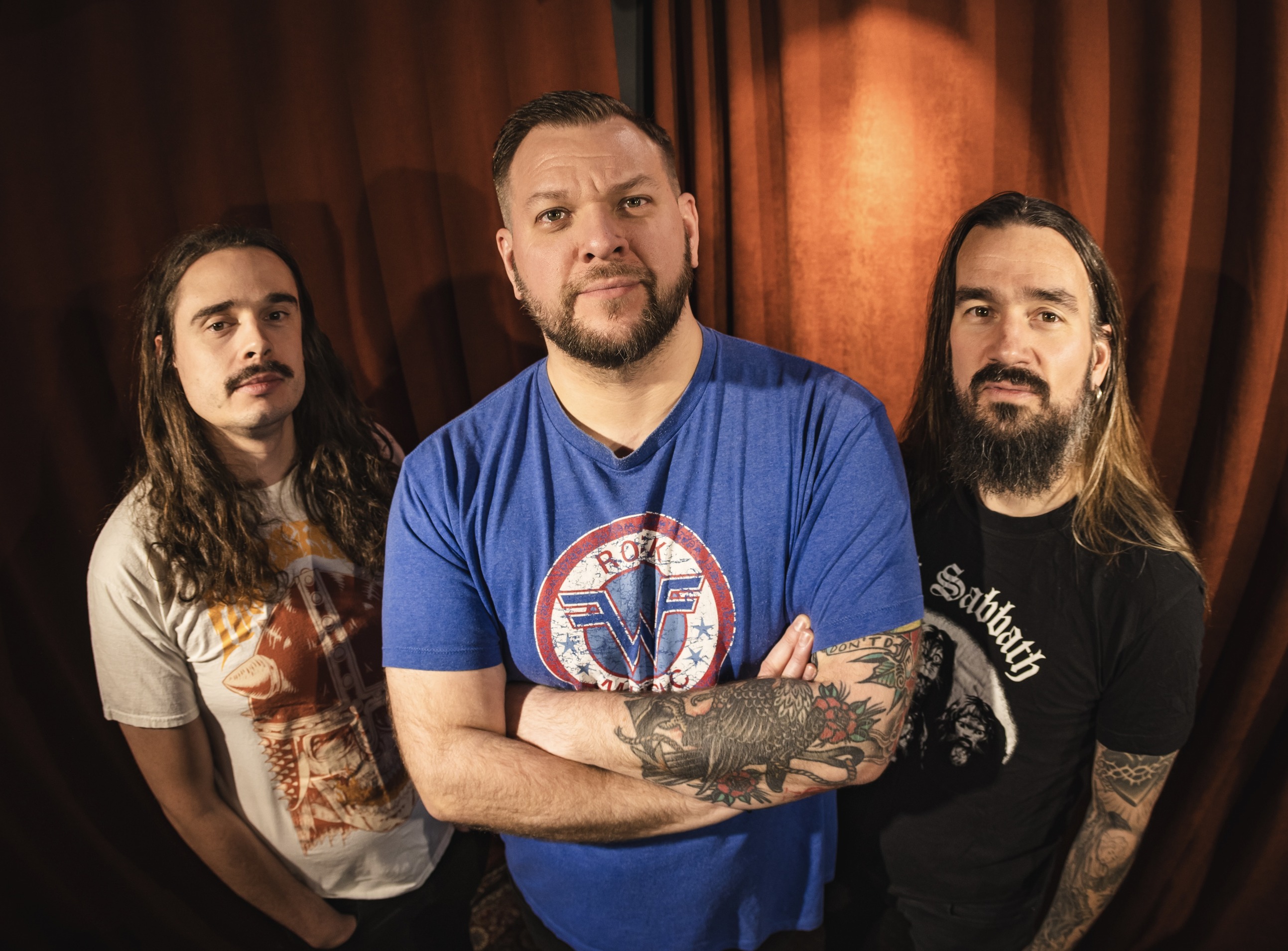
To kick things off, it’s now some 9 months, I think, since All Out Of Dreams was released – how has the reaction been to the new album?
I feel that people really loved this album, which is always a good feeling. Also, some of the other… I don’t know, I didn’t always get the feeling that everyone liked, for example, 2021’s Molotov Rocktail, and this time around it seems like everybody’s kind of on board, which is always nice for us.
I mean, we really liked Molotov Rocktail as well, but it felt like people really connected with this one – both in reviews and in the audience. We’ve been playing a lot of shows on this release tour, both abroad and in Norway, and it’s always good when people know the lyrics already. It’s always a good feeling.
The thing about Bokassa is that you’re very diverse and, I think, that can be a challenge. One of the things I’ve been discussing with people recently is that, when the internet first began to blow up, there was this idea of democratisation and people being able to explore all sorts of different types of music and different types of bands, but my feeling is that it’s almost gone the other way, with people becoming more narrow in their choices – do you think that’s part of the issue?
Actually, I talked to our agent in Norway who books us the other day on the phone. We were just talking in general about stuff and we actually got into that topic, because she turned a band down as she thought they were too boring for her taste! And she said that they probably would have given her lots of money because they’re a popular band, but she just doesn’t connect with bands that are just metal or just rock.
Then, for us, she said “I like the weird ones” [laughs]. Which, I guess we are. To me, it’s not weird. I can listen to say Queensryche, love it; then I’ll put on some NOFX; then some Entombed; and then maybe some Guns ‘n’ Roses or, I don’t know, some hardcore. For me it’s kind of natural. So, I try to just blend it. I like to do, like, here’s a Mastadon-esque riff, then go into a punk verse; or let’s do this really poppy chorus, and a heavy breakdown.
But I do get what you’re saying, because I do think if you really want success, you should just keep it, like, “hey we’re nu metal!” Or heavy metal, or thrash. For us, especially with Molotov Rocktail, which was a record genre-wise that was all over the place, we thought it was awesome; but people were like “I like this part, I don’t like that”. Or they could have been confused!
I mean, also on this one, we have one song [Everyone Falls In The End] that’s, I don’t know what you call it, it’s like metallic hardcore and it’s 40-seconds long; and then you have some kind of, I don’t know, like big, metal song, like Crush (All Heretics) – the 5-minute one, which has a stomp riff. It’s two very different things. Then there’s something like Let’s Storm the Capital, which is basically a pop-punk song. So, for me, I love it when bands do that, but I understand that not everyone does it because the audience gets confused!
So, yeah, I think, probably the easier path for us would have been to make Divide and Conquer – like that kind of thing. I mean, I also think that album is diverse, but the sound there is like – you can fool people into thinking that it’s just High on Fire because of the sound. But yeah, Immortal Space Pirate (The Stoner Anthem) is basically a prog song, you know, and then you’ve got Genocidal Tendencies, which is very metallic – it’s a sort of Machine Head thing. And then Last Night is more punk. So, I think it is diverse. Maybe not as diverse as now, but the sound there is very High on Fire – I call it the High on Fire sound because it’s just like 15 guitars, you know? [Laughs]
It’s interesting, because I do think in many ways that it’s one of the key differences between musicians and, say fans. Very often, the musicians I speak to tend to be interested in a whole range of stuff, and that’s what makes their music interesting – if you only listen to punk, you’re going to have a very straight-forward punk sound, right – but I’m not sure that’s always the case with fans, who are perhaps a bit more focused on one genre.
Yeah, I hear what you’re saying, and I think that, in the beginning with us, I think a lot of people were probably “what are they doing now? They should just be doing this!” And I think some people dropped off because they were like “we’re not interested, we just want what you already did.” And that’s fine, but I think we’ve probably taught those who remained that we’re going to do some different stuff – we’re going to have some weird ad libs; we’re going to have some very catchy stuff, some heavy stuff and, if you like that, hey, you’re on board. And I think they’ve come to understand, and I think that’s why All Out of Dreams had a better reception than Molotov Rocktail, because I think people have come to know what we’re going to do. But I think it’s also a bit of a trick of the mind, because that record is purposefully mixed really metallic. Because I felt like we had these different sounds on the record, but I wanted it to be like cold, I wanted the ping-snare and all – and I think that tricks people into thinking that it’s heavier than it is [laughs]. Yeah, that’s just my theory! [Laughs]
One of the things I enjoy about the album is that it is so much fun. And you’ve got that song, Everyone Falls in The End, which is less than a minute, and it smacks you round the head. But I like that because it gives the album such a surge of energy – and it sounds like you had a lot of fun in the studio producing this.
Yeah, yeah. It was probably the best time we had in a recording studio. Like, we were in rural Denmark in the summer, between Tons of Rock festival and Hellfest, and we just went to Denmark for two months and Tue Madsen, the guy we recorded with; he has a residential studio where you live. So, we lived in this old farm, which he’s turned into a studio, and the neighbours have made nature wine, and they made their own cured meats. And we had like rented cars, we drove into town to grab some food, which we grilled each night, and we had some wine… So, we had the best of times there. And then, he was, like… Danish and Norwegians are always really close, but the Danish are like a more relaxed version of Norwegians, so it was like… we have sometimes recorded with people who are very rigid with where we start and finish, but he likes to start like midday – not midday, but like 10/11, which is perfect. I know Olav likes to wake up at 6, I like to wake up quite late [laughs] have my coffee and whatever. So, we had a very good time, it was great. Usually, it’s very stressful in the studio, very intense. And it was this time as well, and it was just a vibe of being there and usually you go home and whatever you deal with you have to do. But, since we were just there, it was very focused. So, we’re going to do that next time too, I think. It felt superior to doing it here and there in Oslo or whatever.
I think it makes all the difference because, as you said, all those distractions of life disappear for a very concentrated period. I think you bond with the band and producer better when you’re forced into a creative environment like that.
Yeah, absolutely, and no one can leave, you know, for better or worse! Because there’s always someone who’s not going to be… like in any situation, some people are going to be very into it, some people are going to be a little into it and some people are going to be more like “I’ll do my parts and then I’ll go home”. But, when you’re forced to just be there, you feel more a part of the record as well, I think.
I always… I have a number of slightly geeky questions that I often ask, and one is about the sequencing of albums because I’m such a fan of the album as a thing. And particularly because you are more diverse, do you have an idea of how the album will go at the start, or do you pull it together when you’ve finished recording? And how long does it take to make it flow in the way you want it to?
I use a lot of time on sequencing our records. Side A and side B, I think a lot of times, I try different mixes – I’ve done that for all our records – and, this time, I think Olav also made different mixes, and we test it, and we go around with it and see how it flows. And we listen to side A and side B and see how it feels. And there’s always the idea of the big closer, you know, with these more proggy, slower metal songs that we do. And then you start with some… where you don’t have an intro, you start with some right-in-your-face kind of thing, and then you have, for example, a track like Gung Ho, which is more of a groovy, kind of desert kind of thing. That is something I think where you do that after, ah, maybe you’ve come down to the record and maybe you want something different. Same thing with Everyone Fails, so I try. And I try not to have similar songs too close, so yeah, there has to be a vibe… as the kids say [laughs]. I use a… every record, I use a lot of that. I think for the most part I’ve got it right, but there are some things I would change on some, so yeah [laughs].
There’s a magic to it, and I think the shift back to vinyl has really helped, because if you look at records in the 90s, they were so focused on the CD, that you got records kind of stretching out into that space, but vinyl is much more focused, I think.
Yeah, and I think also, for some reason, they just wanted to fill a CD. Like, you can have 74-minutes, but that doesn’t mean you need it. So, there’s a lot of those… I mean, I love like punk and metal and rock from the 90s, but there are some records where the “filler” term came from. Because, if you look at records from the 70s, they were often 7 or 8 songs. So, when you have a point where you have 15 songs, you look at them and you’re like “why did you put that on? It could have been this iconic, great record, but then you’ve got these four songs that are downright bad, or not that good.” So, yeah, I think it was a thing to fill more minutes.
And you also get that from some record labels. We always argued that point, because they gave you like “a record has to be so many minutes.” And we were like “well, what if the record’s great, but it’s just 35-minutes?” You have to argue it because they just want the minutes for minutes’ sake. So, yeah.
Another thing that stands you apart in terms of that, like, classic rock vibe, is the great artwork – especially on the new album. It’s just made for vinyl – how involved are you in the process and who does it for you?
We’re very involved, actually. I have chosen all of our album covers and some of them, from the EPs, I kind of… I didn’t make them, but I searched old creative commons images for hours to find the right photo, because they look so creepy. You know, old 40s and 50s images.
But yeah, every time, I think it has to fit the vibe for the kind of record. Because we had another cover for All Out of Dreams, but I didn’t feel that it fit the vibe, so we went with Therese Haaland, who made, like six years ago I think, a shirt design for us, which was great. And I just found that picture and there was something about it that was perfect for that record and the title.
And the other ones, they were just, like looking at a lot of artists and seeing what they made and seeing if it could fit. Rarely have we done custom jobs. We do it for merch and we do it for some things. I mean we havedone it for our covers and then never used the art! Sometimes, maybe we had an idea that this should be the cover, we got someone to make it, we got it, we paid for it, and then we realised it didn’t fit! So, every time we’ve done that, we ended up paying for something we never used. Maybe we’ll use it for a deluxe edition, like where we have two alternate record covers that we never used, just lost in our Dropbox! So, maybe we can do that for a special, deluxe version of Crimson Riders or All Out Of Dreams, but yeah, I feel it’s better just to see someone’s artwork and just feel that it fits, that it’s perfect.
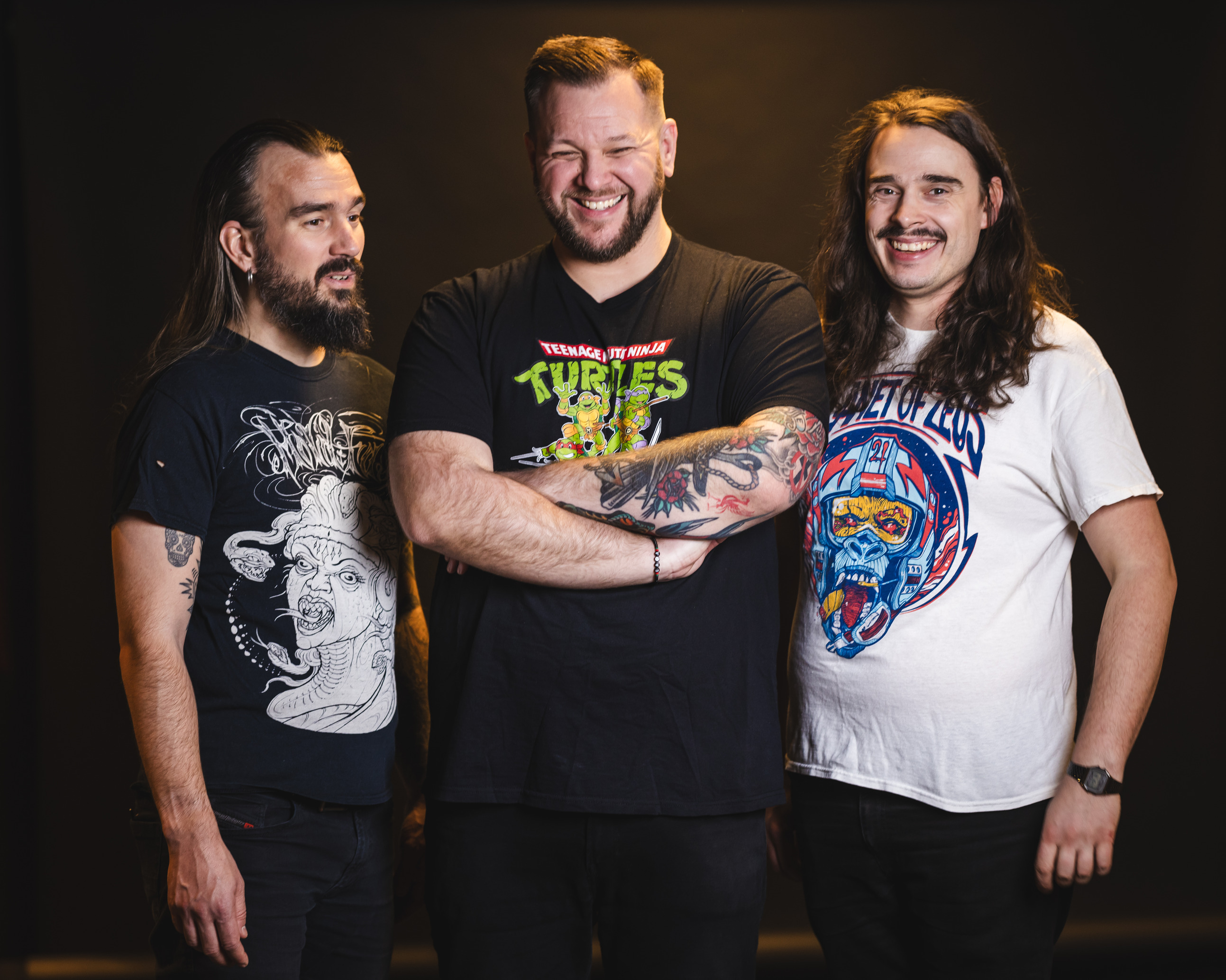
You’ve got two amazing guest spots on the album – the legendary Lou Koller from Sick Of It all, and Aaron Beam from Red Fang – and it’s always interesting to me, because it’s so exciting to collaborate with other musicians but, at the same time, if you’re working with people who have a very defined sound, there’s some give and take about how you approach the music – at what point did they get involved in the songs and how much were the songs tailored to them?
Well, everything was about lyrics. The melody and that kind of stuff was finished when we got them on board so that was basically just, we sent them the song and, if they like it, would they sing this part – and then I sang, like, a placeholder, so they could see how it would be done. We had an idea that their voices would fit the song in that part – Lou on the breakdown, with his iconic scream; and on Bradford Death Squadron, which is the most stoner song we’ve done in years, I thought it was fitting to have Aaron from Red Fang playing there and there is something about his voice that I think really fit that part of the song. So, luckily, they liked the songs and said “yes” [Laughs] Which was cool for us!
Is there a slight risk that having the name attached to it pull people’s attention away from the song? It seems like a challenging balancing act.
Not for us. We kind of… I think we thought that maybe people would be [laughs] more interested in it because of that, but it really didn’t seem that way [laughs]. I don’t know why, but I feel like a lot of fans, if it’s not, like…I mean, of course, there are people everyone knows but, for a lot of people, if it’s not James Hetfield or Ozzy Osbourne, they don’t really know who people are by their names! They’d know it if it was a band, but they don’t necessarily know that’s the singer of that band, you know. That’s just what I’ve found. But I could be wrong. But it just seems that people don’t necessarily know people’s names. They know bands.
A lot of people don’t know, say, even song names. They know Sweet Child O’ Mine and November Rain, but they don’t know Double Talkin’ Jive [laughs]. So, I feel most people just enjoy stuff and don’t necessarily know, whereas I’m the opposite… but I have this brain that remembers useless information! [Laughs] Like names of bass players [Laughs]
I’m the same! My final question, and thank you for this really interesting interview, is that you have these live sets coming up and, because you pay such attention to sequencing your albums and they flow so beautifully, so you pay the same attention to live set lists, and are you constrained, kind of, by what you think people want to hear?
Yeah, I think we focus a lot on the journey. And also trying to have dynamic in the type of songs. So, of course we have some songs that are like the basis of the whole set, and then we have places where we switch from songs to songs. Maybe we do a deep cut there, and basically, if people… at least in Europe and Norway, there are a lot of people who come to a lot of our shows, and I don’t want them to get 100% the same show, so we try to change two or three songs each night, but the base is often the same, because we think it flows quite nicely. We changed once because a friend of mine was like “are you starting the set with Last Night again?” So, we were like, “OK!” and put Charmed & Extremely Treacherous as an opener. But we feel like after that slow, doomy intro, you want a kick in the face with a fast one and then maybe some certain points, the melodic stuff, then maybe a short one, a long one… so, yeah, we think a lot about that.
I love the fact that you include deep cuts, because that’s where a lot of people become fans, because you hear something that’s not a single, fall in love with it all over again, and it makes you want to go back and listen to the whole album.
Yeah! We also try, like, if people send us via Instagram DMs, or if they just request a song, we try to… if we can, we try to rehearse it before that show. Sometimes it’s just like, if it’s too deep then we might have just forgotten how it goes! [Laughs].
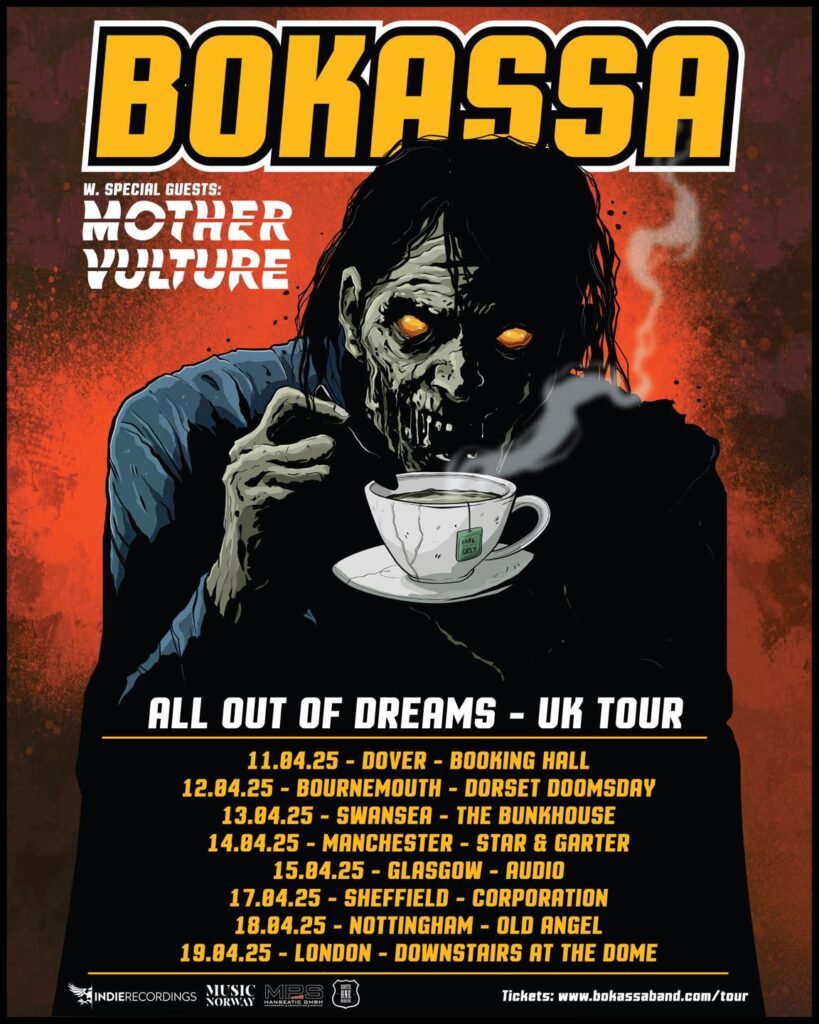
Bokassa are set to hit the UK for a run of dates:
April 11th, 2025 – Dover, The Booking Hall
April 12th, 2025 – Bournemouth, Dorsel Doomsday
April 13th, 2025 – Swansea, Bunkhouse
April 14th, 2025 – Manchester, Star & Garter
April 15th, 2025 – Glasgow, Audio
April 17th, 2025 – Sheffield, Corporation
April 18th, 2025 – Nottingham, Old Angel
April 19th, 2025 – London, Downstairs at the Dome

